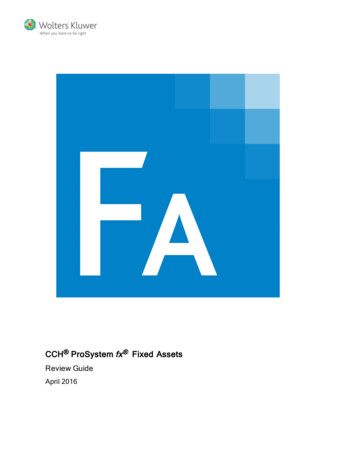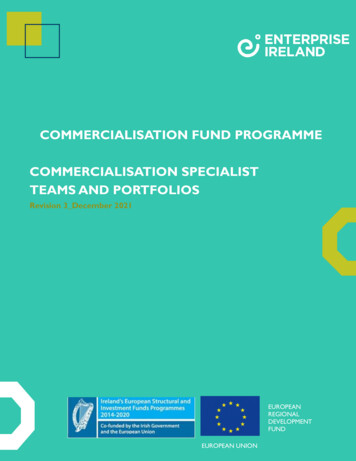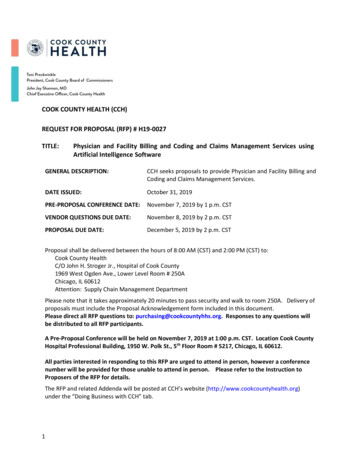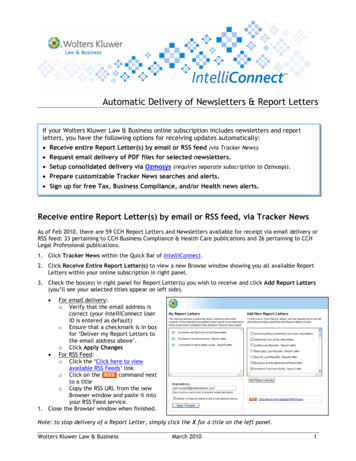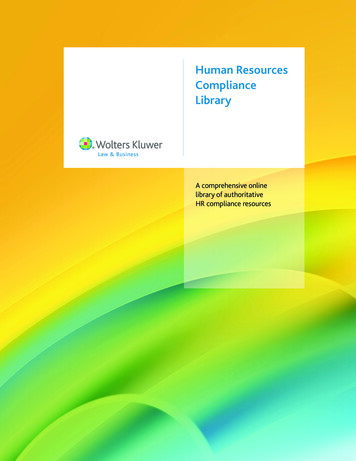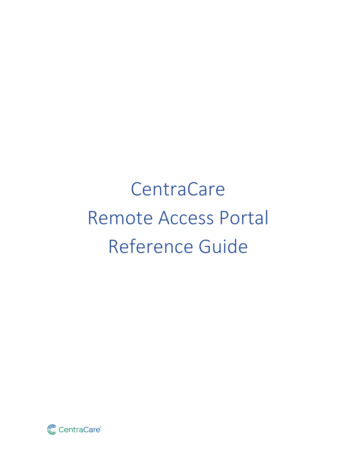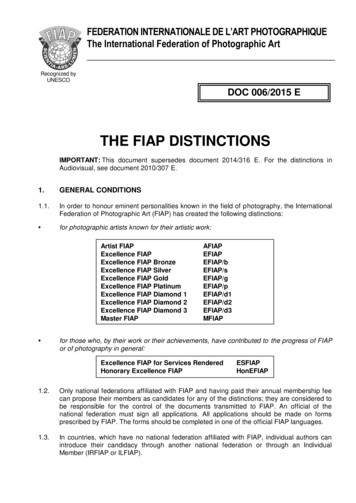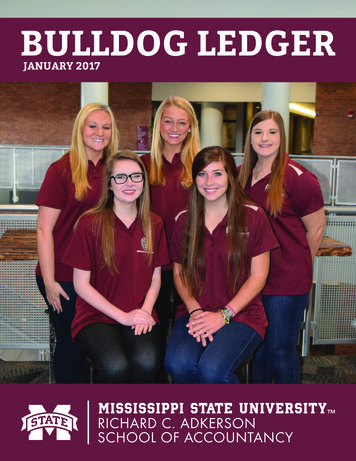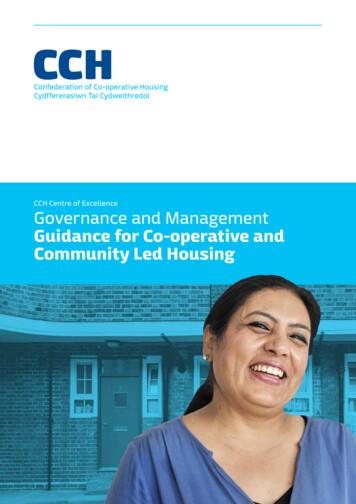
Transcription
CCH Centre of ExcellenceGovernance and ManagementGuidance for Co-operative andCommunity Led Housing1
CCH Centre for Excellence – Governance and Management GuidanceCo-operative andcommunity-led housingorganisations are.developed by, with andusually for a democraticcommunity membershiporganisationcontrolled (and in somecases owned) by a localdemocratic communitymembership organisation2
This guidance isdesigned to supportgood governance andmanagement in new orexisting co-operative andcommunity-led housingorganisations (referredto for ease of referenceas organisationsthroughout the guide).It is intended to be ofuse by the governingbodies, their members,their staff and otherstaff working to supportthe sector and otherpartners.1This guidance explains what goodgovernance and management is forany co-operative and communityled housing organisation and looksat governance and management insome specific circumstances (mostnotably if an organisation is registeredwith their Government regulator1probably because they received someGovernment funding to build theirhomes).Co-operative and community-ledhousing organisations come in manyshapes and sizes. That’s what makesthem successful. They are aboutpeople considering local issues andusing bespoke methods to developwhat’s right for them.for ease of reference, these are referred to in the guidance as registered organisations.3
CCH Centre for Excellence – Governance and Management GuidanceNo two schemes are quite the same. Theycan be set up for a wide range of differentreasons and to meet various needs; theyare in different locations; their legal andother structures can be quite different;they own and manage different types ofhomes; they house different groups ofpeople. They vary from the very small(in some cases just one house shared bya group of members); through to largerlocally based organisations (which couldown or manage any number of homes);up to large hybrid area based mutualsowning up to 15,000 or more homes.Some are set up specifically to house theirmembers. Others are set up by communityorganisations seeking to address localhousing need. It’s a diverse sector unitedby its principles of democratic communitymembership.Co-operative and community-led housingorganisations have different “GoverningBody” arrangements. Some are governedby all the members through generalmeetings; some have managementcommittees or Boards as their governingbodies. The housing service can bedelivered in different ways. Volunteersmay provide a hands-on service; directlyemployed staff or external serviceproviders may be used; some lease theirhomes to other organisations to manage;and there might be permutations of these.For each organisation, there will be anappropriate and proportionate way inwhich they could apply this governanceand management guidance which willbe shaped by their size, governingbody arrangements, service deliverymechanism and what stage they havereached in their development. A newstart up organisation will have differentgovernance and management prioritiesfrom a long standing organisation.Membership is referred to throughoutthe guidance because it lies at the heart4of any co-operative and communityled housing organisation. However,how each organisation engages with itsmembers will vary. For example, in asmall co-op with four members, everymember will engage directly. In a largemutual with several thousand members,membership engagement may be throughrepresentative bodies.This guidance does not prescribe howthings should be done - it aims to assistorganisations to consider the issues theyneed to consider; how they can makeinformed and democratic decisions thatdeliver the best governance solutions,services and positive results.Good governance is a journeyBecoming an excellent organisation in allthe areas we have listed below might feellike a daunting and impossible challenge– both for an organisation just startingout – and for one that has been goingfor many years. It’s not intended to be.Good governance is a journey – wherethe organisation has targets to aim for– achieving well in some areas whilstworking over time to improve others. Ourguidance is designed to help organisationsidentify where they are trying to get to,but probably no organisation is ever 100%excellent in every area.As well as – there are many organisationsout there who can provide help andassistance. Many national and locallybased organisations, including the CCH,provide guidance. The CCH has alreadyproduced written guidance in someareas of governance and managementand intends to produce further guidancedocuments.For further information, pleasecontact the CCH.
Governance and management checklistThe guidance is based on a check list of key questions that are aimed at helpingorganisations self-assess their governance and management. A Governance & ManagementWorkbook is available from the CCH (at info@cch.coop) to help co operative and communityled housing organisations carry out self-assessments.The three areas of governance and management are set out in summary below.Further detail is then provided on what makes an excellent and a dysfunctional organisation.Values &PrinciplesWhat is the organisation about?How does it interact with its membership?a) When did the organisation last review its mission andvision and how were members involved in the review?b) Is the organisation learning, sharing and outwardlooking?c) Does the organisation’s approach towards equality anddiversity ensure fair outcomes?d) How are members involved in the organisation?e) How does the organisation bring in new members?What information are new members provided with?f) How does the organisation manage conflicts of interest?g) Does the organisation have a succession plan?Does it provide training to its members?Does it consider demographic change within itsmembership?h) How does the organisation manage confidentialinformation and ensure that it complies with theData Protection Act 1998?5
CCH Centre for Excellence – Governance and Management GuidanceGovernance& Viabilityis the organisation operating in accordance with anappropriate Code of Governance? Is the organisationfinancially viable?a) Does the organisation carry out an annualassessment of compliance with a Code of Governance?b) What plans does the organisation have in place to ensureits long-term viability?c) If the organisation is developing new homes, how does itensure the financial viability of new schemes it developsand does it understand implications on its business,finance and other plans?d) Do members of the Governing Body have the informationthey need to make informed decisions?e) Is the organisation keeping all the legal, statutory andregulatory records that it needs to? Does it make thereturns it needs to?f) Does the organisation have a clear, comprehensive, up todate, and periodically reviewed suite of policies andprocedures?g) Are roles and responsibilities clear? Are committees,officers, staff, service providers clear about whatdecisions they can take?h) How are meetings conducted?i) Are there appropriate staffing and supportarrangements? Are there are effective contractprocurement and management arrangements?j) Is an annual budget approved and is there appropriatemonitoring of financial performance?k) Does the organisation have an appropriate set ofFinancial Standing Orders?l) Is there clarity regarding payments to members?m) Is the organisation complying with its regulatory andlegal accounting duties and any loan covenants?n) Does the organisation consider how best it can get Valuefor Money out of its resources and assets?6
Managementis the organisation managing effectively and deliveringexcellent results?Successful management for each organisation is dependenton what mission, aims and objectives it has set for itself.Some of the questions below may not be relevant toparticular organisations, although most are required to beassessed for registered organisations.a) Is the organisation achieving its objectives in relation todeveloping new homes or adapting existing ones?b) Is the organisation achieving its community objectives?c) Is the organisation achieving its environmentalobjectives?d) Are residents of homes owned or managed by theorganisation getting good services in their homes?e) Do new and potential residents gain access to theorganisation’s homes in a fair, open and transparent way?f) Are appropriate legal occupation agreements (eg. tenancyagreements, leases, covenants in freehold agreements)issued and are they explained to new residents?g) Has the organisation agreed standards for lettingempty homes?h) Is a high-quality repairs service provided that fits inwith what residents want and legal requirements?i) Is there a fair and appropriate approach to setting rentsand service charges, and for dealing with non-payment?j) Is anti-social behaviour and neighbour nuisanceeffectively prevented and tackled?k) Are complaints and disputes dealt with in a timely andeffective manner?l) Are other tenancy, lease and covenant matters dealtwith effectively?m) Are regular health and safety and fire risk assessmentscarried out where necessary and appropriate?7
CCH Centre for Excellence – Governance and Management GuidanceUndertaking aSelf-AssessmentIt is suggested thatmembers of theGoverning Body:a) individually complete the selfassessment contained within theGovernance and ManagementWorkbook, allocating a score between 1and 5, where 1 means that theorganisation has not thought about theissue at all through to 5 where theorganisation has given comprehensivethought to it and has made plans toaddress it.b) where applicable, seek views fromother members, staff members or otherorganisations the organisation workswith regarding how they would scoreit in relation to some or all checklistquestions.c) meet up with each other (at an away dayor a meeting) and share and discusstheir individual results, particularlyconsidering any differences of opinion.d) develop an action plan that focuseson addressing those checklist questionswhere low scores were agreed.8
Values &Principles
CCH Centre for Excellence – Governance and Management Guidancea) When did the organisation last review its missionand vision and how were members involved inthe review?4 An excellent organisation:has a clear idea of what it’s there for– what it’s trying to achieve – and themain things it believes in. These thingsare usually set out in written missionstatements and statements of values andvision2. Values are fundamental to CCLHorganisations - members understand andparticipate in developing and periodicallyreview them.8 A dysfunctional organisation:muddles along, never considering what it’spurpose is or what values it stands for. Itnever has dialogue with its members aboutits values, assuming that, or not evencaring whether the values of the governingbody are shared by members.b) Is the organisation learning, sharing andoutward looking?4 An excellent organisation:learns by sharing skills, knowledge andexperience throughout its membership andby being a supportive organisation. Howit works and networks with other similarorganisations and/or with other relevantorganisations enables it to formulate anddraw on good practice and develop as anorganisation. Registered organisationsneed to keep abreast of relevantdevelopments in the broader housingassociation sector.A set of internationally defined Co-operative Values and Principles lie at the heart of a co-operative’s identity. Some or allof these principles may also have resonance with other organisations. The Co-operative Values and Principles are detailed inAppendix One.2108 A dysfunctional organisation:does not share or learn either internallywith its members or externally withother similar organisations or otherorganisations from whom it could learn.Consequently, it has been plodding alongyear in year out, never learning, neverdeveloping.
c) Does the organisation’s approach towards equalityand diversity ensure fair outcomes?4 An excellent organisation:welcomes and supports members fromdiverse backgrounds and helps them toshare, interact and achieve consensusfrom different ideas and viewpoints. Itcarefully considers its equality and4diversityapproach, ensuring that it doesnot directly or indirectly discriminateagainst any particular group. Itparticularly ensures fair outcomes inrelation to access to homes, how servicesare provided, how any staff, agencies/contractors are appointed and howmembers are involved.8 A dysfunctional organisation:is dominated by cliques, has regularuncontrollable conflict, with factionsplotting and scheming against eachother. Large groups of members aredisenchanted with and have given up onthe organisation’s democratic processes.There are unfair and discriminatorypractices going on throughout theorganisation, and the clique in chargeseeks to ensure that only their views holdany sway within the organisation.d) How are members involved in the organisation?4 An excellent organisation:considers whether people coming tomeetings, those on the Governing Body,or those who participate in other ways,are representative of the full membership.It regularly reviews its success inencouraging member participation. It hasdifferent ways for members to contribute– through formal meetings as well asperhaps through less formal groups,digital media and socially. It periodicallyfinds out the views of all membersindividually and its decision-making isinformed by those views.8 A dysfunctional organisation:has an involvement approach that reliessolely on a member’s opportunity to attendgeneral meetings, but only those in chargeactually attend them. Very few are activelyinvolved and there are no other ways toparticipate apart from through formalgoverning body or general meetings.There is no active community life in theorganisation, and the organisation neverfinds out the views of its members.A set of internationally defined Co-operative Values and Principles lie at the heart of a co-operative’s identity. Some or all ofthese principles may also have resonance with other CCLH organisations. The Co-operative Values and Principles are detailedin Appendix One.211
CCH Centre for Excellence – Governance and Management Guidancee) How does the organisation bring in new members?What information are new members provided with?4 An excellent organisation:actively considers how effective it is atinducting new members, providing formaland informal support. It provides writteninformation on how the organisation isstructured and what services it provides,and how members can get involved andassess performance. Where new membersare housed by the organisation, steps aretaken before and after they move in toensure that they are inducted effectively asmembers.8 A dysfunctional organisation:just signs up new members because itis a formality that needs to be done. Itdoesn’t provide new members with anyinformation on how the organisationworks or how they can get involved. Therelationship between the organisation andnew resident members is based solely onthe tenancy agreement or lease, and newmembers rarely if ever get involved in theorganisation’s democracy.f) How does the organisation manage conflictsof interest?4 An excellent organisation:has a clear documented system fordealing with conflicts of interest to ensurethat personal interests do not influencedecision-making. It has systems toensure that members cannot defraud theorganisation or personally benefit fromtheir involvement. Members declare anyconflicts of interest prior to issues beingdiscussed and the organisation maintainsa Register of Interests where membersparticularly record any financial conflictsof interest they may have with anyone thatthe organisation does business with.128 A dysfunctional organisation:has members who use the organisationto further their own personal interests.Members who have conflicts of interestdo not declare them and unduly influencedecision-making to favour their personalinterests. Decisions about who theorganisation provide homes to are alsoinfluenced by personal interest; orfinancial or other relationships are enteredinto as a result of personal interests.Some governing body members may bedefrauding the organisation.
g) Does the organisation have a succession plan?Does it provide training to its governingbody members?4 An excellent organisation:prepares to renew and replace governingbody members before they stop beingactive. It has a training programme thatsupports future sustainability.8 A dysfunctional organisation:hopes for the best! Its active governingbody members are increasingly elderly andno one steps forward to replace them.h) How does the organisation manage confidentialinformation and ensure that it complies with theData Protection Act 1998?4 An excellent organisation:understands its responsibilities forensuring compliance with the DataProtection Act 1998 and reflects thiscompliance in a Confidentiality Code. Itensures that it has systems to ensureconfidentiality regarding personal,business and other areas that requireconfidentiality.8 A dysfunctional organisation:does not comply with the Data ProtectionAct 1998. Personal data is kept and sharedthat should not be. Personal, businessand other confidential information isleaked. No action is taken to respond toconfidentiality breaches or to preventthem.13
CCH Centre for Excellence – Governance and Management GuidanceThe Information Commissioner3,who oversees compliance andpromotes good practice, requiresall Data Controllers who processpersonal data to be responsiblefor their processing activitiesand comply with the eight dataprotection principles of ‘goodinformation handling’.314These are:1 Personal data shall be processed fairly& lawfully2 Personal data shall be obtained onlyfor one or more specified and lawfulpurposes3 Personal data shall be adequate,relevant and not excessive4 Personal data shall be accurate and,where necessary kept up to date5 Personal data shall not be kept forlonger than is necessary6 Personal data shall be processed inaccordance with the rights of datasubjects7 Security principle - protection againstunauthorised /unlawful processing8 Transfers outside of the EEA (EuropeanEconomic Area) - requires adequatelevels of protectionFurther information can be obtained from the Information Commissioner Office at www.ico.org.uk
Governance& Viability
CCH Centre for Excellence – Governance and Management GuidanceCo-operative and community-led housing organisationshave various Governing Body arrangements. Whilstthey are membership organisations, where membersare usually legally entitled to have their say and castvotes at General Meetings of the organisation, all have alegally defined Governing Body which is responsible formaking decisions in the organisation. In some (usuallysmaller ones), the Governing Body is the GeneralMeeting; in others, the organisation has a ManagementCommittee or Board as their Governing Body to directmanagement on behalf of their members.a) Does the organisation carry out an annualassessment of compliance with a Code ofGovernance ?4 An excellent organisation:annually assesses its compliance witha Code of Governance, explaining anyareas of non-compliance. Registeredorganisations are required to include astatement of compliance with a Code ofGovernance and with the Governanceand Viability Standard in its FinancialStatements.The CCH, in partnership with the National Housing Federation, has produced a Code of Governance for housing co-ops which isavailable at www.cch.coop/code-of-governance. This may be applicable to other community-led housing organisations or theymay be able to adapt it or another Code of Governance to suit their circumstances.4168 A dysfunctional organisation:does not know what governance standardsit should be complying with and does notassess its compliance.
b) What plans does the organisation have in place toensure its long-term viability?4 An excellent organisation: has a long-term business plan that setsout what it aims to achieve and how itwill achieve it; has a long-term finance plan to supportits business plan; has a reserves plan keeps an up to date assets andliabilities register ensures that there is an assetmanagement plan (if the organisationowns property assets) that isperiodically updated with residents manages risk effectively ensures appropriate insurance coverwhich is periodically reviewed involves members and/or residentsappropriately in determining all ofthe above8 A dysfunctional organisation:muddles by. It doesn’t have any longterm plans (finance or otherwise). It hasno plans for its reserves, usually keepingthem in the bank where they graduallydepreciate. It doesn’t know what assetsit owns or its future liabilities. It doesn’tknow what it will take to maintain itsproperty assets and hopes it will get bywhen the time comes. It has no idea whatrisks it faces and it has not checked foryears if its homes are adequately insured.No members or residents are involved indiscussions about any long-term planning.A Reserves Plansets out how an organisation will maximise the financial and social returns from itsproperty and cash assets.An Assets and Liabilities Registerenables an organisation to have clear knowledge of its overall finance and asset positionand liabilities that have recourse to its assets (such as loans secured against properties).An Asset Management Planenables an organisation that owns property assets to ensure that its homes are warm,weatherproof and have modern facilities in perpetuity. If an organisation owns homes,it should ensure that there is an effective asset management plan, even if this is done byanother organisation that is managing the homes on the organisation’s behalf. An assetmanagement plan enables planning to replace all elements of the home. Residents shouldbe involved in the Asset Management Plan. They have good knowledge of what needsreplacing and how it should be replaced. They should be supported to get involved in thedesign and implementation of major works contracts and recruitment of contractors. Theyshould be kept informed of the progress of major works programmes being carried out ontheir homes.17
CCH Centre for Excellence – Governance and Management GuidanceRisk managementenables an organisation to identify the risks their business faces and make appropriateplans to protect itself against them. Risks could be related to development programmes,governance, service delivery, staff, service agencies, consultants or contractors, the law orthe outside world. An organisation needs to have plans in place to recover from disastersto ensure the operations of the organisation can continue.Insurancean organisation may manage some risks by having up to date insurance cover for particularliabilities. Insurances might include buildings insurance, insurance against loss of ordamage to property owned by the organisation, public liability insurance and employerliability insurance (for any staff members). Insurance policies should be periodicallyreviewed, and there should be procedures to handle any insurance claims. Where homesare managed by someone else, the organisation should ensure adequate insurancearrangements.c) If the organisation is developing new homes,how does it ensure the financial viability ofnew schemes it develops and does it understandimplications on its business, finance and otherplans?4 An excellent organisation:has a clear strategy for developing newhomes. It understands the implications ofdevelopment on its business, finance andasset management plans. It has a goodunderstanding of scheme developmentand long term management/maintenancecosts.188 A dysfunctional organisation:has not considered how it might be ableto develop new homes. Where it has, itdoes not understand the implications of itsplans on its business. Its only focus is ondeveloping the homes and it does not giveconsideration to long term managementand maintenance.
d) Do members of the governing body have theinformation they need to make informed decisions?4 An excellent organisation:ensures that its governing body membershave comprehensive information on whatthey are making decisions about. It usuallyprovides this information in advance sothat they can carefully consider decisions.Where governing body members do nothave knowledge of particular subjectmatter pertaining to a decision, it activelyseeks external advice, and if necessary,provides training.8 A dysfunctional organisation:has a governing body that makesdecisions that are not based on adequateinformation. In some cases, only a fewgoverning body members may haveknowledge of the subject matter. Externaladvice is not sought on complex mattersthat governing body members do not knowabout.e) Is the organisation keeping all the legal, statutoryand regulatory records that it needs to?Does it make the returns it needs to?4 An excellent organisation:keeps good quality records, particularlyin relation to its legal, statutory andregulatory requirements. The governingbody is clear where these records are keptand who has responsibility for maintainingthem. The governing body ensures thatits legal, statutory and regulatory annualreturns are made within deadlines8 A dysfunctional organisation:keeps inadequate and partial records.The governing body is not aware of whatrecords are kept and does not ensurethat its legal, statutory and regulatoryresponsibilities regarding annual returnsare complied with.Organisations should check which of the documentationlisted in Appendix two applies to their circumstances.19
CCH Centre for Excellence – Governance and Management Guidancef) Does the organisation have a clear, comprehensive,up to date and periodically reviewed suite ofpolicies and procedures?4 An excellent organisation:keeps a suite of written policies andprocedures that are appropriate for itscircumstances; ensures that policiesare short and clear statements of whatthe policy seeks to achieve and the keyprinciples relating to it and that theyare agreed by members; ensures thatprocedures provide more detail for thoseimplementing policies; periodically reviewspolicies and procedures with members8 A dysfunctional organisation:keeps inadequate and partial policies andprocedures meaning that there is a lack ofclarity about how things should be done;jumbles policies and procedures togethermaking them difficult to understand; doesnot review policies and procedures; anddoes not involve its members in policyreviewg) Are roles and responsibilities clear?Are committees, officers, staff, service providersclear about what decisions they can take?4 An excellent organisation:has clearly defined roles andresponsibilities and authority that isdelegated to committees, officers, staffand service agencies; those with rolesand responsibilities know what decisionsthey can take, what is expected of themand how they report to the governingbody; there are written role descriptionsfor officers and governing body members;terms of reference govern subcommittees and working groups; reportingmechanisms are clear and transparent,particularly regarding delegated authority208 A dysfunctional organisation:has little or no clarity about roles andresponsibilities for officers, committeesand those that work for the organisation.Decision-making outside the governingbody is not reported to the governing body.With lack of clarity about who can takedecisions, either individual members takeit upon themselves to make decisions, orgoverning body meetings include lengthydiscussions about routine matters thatcould be agreed outside the governingbody.
h) How are meetings conducted?4 An excellent organisation:has well-chaired and good naturedmeetings where the chair is supportedby those attending who are enabled toput forward their views in a constructivedebate. Meeting agendas are adhered toand decisions made. The organisationcomplies with its rules about, for example,sending out notices and agendas ofmeetings in advance, keeping minutes, andquorums for meetings. A Code of Conductthat is respected by all attendees governsbehaviour at meetings.8 A dysfunctional organisation:has riotous and poorly chaired meetings;where attendees cannot express theirviews constructively; which ramble offagendas; and there is little clarity aboutdecision-making. The organisation’s rulesare not complied with and there eitheris no Code of Conduct for meetings orattendees do not comply with it and noaction is taken to address non-compliance.i) Are there appropriate staffing and supportarrangements? Are there effective contractprocurement and management arrangements?In the smallest co-operative and community-led housing organisations, voluntary memberscarry out most, if not all, of the organisation’s operational activities. Larger organisationseither employ staff or a service provider to carry out some, or all, of the operationalfunctions. Even smaller organisations may arrange contracts for particular areas of work.4 An excellent organisation:is confident that any staff or serviceproviders have the right skills, knowledgeand experience and that the rightrelationships with them are in place. Suchrelationships are set out in writing andperformance is regularly reviewed.8 A dysfunctional organisation:Does not exercise any judgment aboutthe people or organisations working forit; it has poor relationships with them;there is no written documentation; andperformance is not reviewed.4 An excellent organisation:ensures that any staff it directly employshave formal employment contracts andjob descriptions. The organisation hasappropriate policies and procedures(which it complies with) for recruitment,training and development, disciplinaryand grievances, meeting their legalresponsibilities and for training theirmembers in staff recruitment andmanagement.8 A dysfunctional organisation:does not properly recruit or manage anystaff
Governance and management checklist The guidance is based on a check list of key questions that are aimed at helping organisations self-assess their governance and management. A Governance & Management Workbook is available from the CCH (at info@cch.coop) to help co operative and community-led housing organisations carry out self-assessments.
